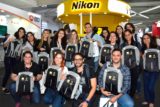
Are you on X?
Follow Nikon Instruments for microscopy news and trends, updates on new products, and information on contests and promotions.
July 23, 2018, via Nikon Instruments

Thank you to everybody who visited Biolab Brasil, Nikon’s authorized high-end research microscope dealer in Brazil, at this year’s SBBC 2018 Meeting in Sao Paulo! We hope to see you next year.
July 19, 2018, via Cell
New research in Cell tackles the biology of minimal residual disease (MRD) – the small number of cancer cells remaining after treatment – to identify key drivers of therapeutic resistance. Confocal imaging was performed using a Nikon A1 system.
Learn More @ Cell
July 18, 2018, via Imaging Resource
Did you know that Nikon designs its own sensors? Nikon-designed sensors can be found on the award-winning D850, as well as our Digital Sight series cameras for microscopy. Click to take an unprecedented look into Nikon’s sensor design and manufacturing process!
Learn More @ Imaging Resource
July 17, 2018, via OSA - The Optical Society
Laser chromosome welding may sound like sci-fi, but researchers have demonstrated a new technique using pulsed violet lasers to cut and paste chromosome fragments. Click to learn more!
Learn More @ OSA - The Optical Society
July 16, 2018, via Current Biology
Imaging with a Nikon upright microscope helps identify the last meal of 5300-year-old Iceman, finding a high fat diet supplemented with meat and cereals.
Learn More @ Current Biology
July 13, 2018, via Cell
Researchers characterize #dopamine dynamics using a new genetically encoded fluorescent dopamine sensor and a Nikon A1 confocal microscope. Click to learn more!
Learn More @ Cell
July 12, 2018, via Nikon Small World
Thanks to everyone who attended our Nikon Small World Exhibit Reception at the MBL in Woods Hole, MA. The exhibit will be open to the public through July 27 at the MBL Club, please come check it out!
Learn More @ Nikon Small World
July 11, 2018, via NASA
Researchers have developed a miniaturized 3D fluorescence microscope for use onboard the International Space Station ISS. This technology will help enhance our understanding of cellular adaptation to microgravity. Click to learn more!
Learn More @ NASA
July 09, 2018, via PHYS.ORG
Wow, new scanning electron microscopy SEM method works while at 1000 degrees Celsius! This method opens new doors for testing the performance of materials for nuclear reactors and aerospace applications.
Learn More @ PHYS.ORG
July 08, 2018, via Nikon Instruments
FENS2018 is in full swing! Come visit us at Booth 124 and discover how Nikon can help you with deep and live confocal imaging solutions.
Learn More @ Nikon Instruments
July 06, 2018, via Science Translational Medicine
New research in Science Translational Medicine finds that heroin addicts have much higher levels of hypocretin-producing neurons. Conversely, narcolepsy is caused by loss of hypocretin neurons, and can be restored via administration of morphine. Imaging was performed with a Nikon upright microscope.
Learn More @ Science Translational Medicine
July 05, 2018, via Nature Scientific Reports
Over 140,000 people died in 2012 due to oral squamous cell carcinoma (OSCC), the most common type of oral cancer. Researchers are fighting OSCC by making new fluorescent markers for microscopic identification of the disease at an early stage.
Learn More @ Nature Scientific Reports
July 03, 2018, via PNAS
Violent aggression is a well-known stress response in animals. A new analysis of violent inmates reveals unique autoantibody binding patterns with adrenocorticotropic hormone (ACTH), resulting in higher levels of cortisol. Imaging was performed with a Nikon upright microscope.
Learn More @ PNAS
July 02, 2018, via ESHRE
ESHRE2018 is in full swing! Come visit us at Booth 640 and check out our imaging solutions for the ART cycle. ESHRE - European Society of Human Reproduction and Embryology
Learn More @ ESHRE
June 28, 2018, via ESHRE
Visit us at Booth 460 during the 2018 Annual Meeting of ESHRE - European Society of Human Reproduction and Embryology in Barcelona, and learn how Nikon can support you through the ART cycle.
Learn More @ ESHRE
June 27, 2018, via Cell Systems
Glycolysis is a multi-step mechanism for providing the cell with energy, with dysregulation being a hallmark of diseases such as diabetes and cancer.
New research in Cell Systems uses optogenetics to identify 4 key steps for controlling the rate of glycolysis in cells. Imaging was performed with a Nikon spinning disk confocal microscope with DMD.
Learn More @ Cell Systems
June 15, 2018, via Nature Communications
New research in Nature Communications identifies novel genes involved in cancer cell metastasis and use a Nikon A1R-MP multiphoton system to show therapeutic benefit of RNAi-mediated inhibition of those genes.
Learn More @ Nature Communications
May 25, 2018, via Nature Communications
Worried about light-induced artifacts in your electrophysiology recordings? Check out new research from UC San Diego using transparent graphene microelectrode arrays for artifact-free multiphoton, optogenetics, and cortical recordings in same experiment.
Learn More @ Nature Communications
May 24, 2018, via Developmental Cell
New CRISPR method exhibits higher knockin efficiency than previous, demonstrated in both mouse brain and human embryos. Confocal imaging with a Nikon A1 microscope.
Learn More @ Developmental Cell
May 23, 2018, via Science Signaling
New research in Science Signaling uses a Nikon upright microscope to help uncover new role of a diacylglycerol kinase for enhancing muscle growth in response to exercise, and limiting atrophy.
Learn More @ Science Signaling















